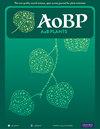Genome-wide investigation of SQUAMOSA PROMOTER BINDING PROTEIN-LIKE genes in Liriodendron and functional characterization of LcSPL2
IF 2.4
3区 生物学
Q2 ECOLOGY
引用次数: 0
Abstract
Premise The plant-specific SQUAMOSA promoter-binding protein-like (SPL) transcription factors play a pivotal role in various developmental processes, including leaf morphogenesis and vegetative-to-reproductive phase transition. Liriodendron chinense and Liriodendron tulipifera are widely used in landscaping due to their tulip-like flowers and peculiar leaves. However, the SPL gene family in Liriodendron has not been identified and systematically characterized. Methods We systematically identified and characterized the SPLs family members in Liriodendron, including phylogeny, gene structure, syntenic analyses. Subsequently, we quantified the expression patterns of LcSPLs across various tissue sites through RT-qPCR assays, hence identified the target gene, LcSPL2. Finally, we characterized the functions of LcSPL2 via ectopic transformation. Results Altogether, 17 LcSPL and 18 LtSPL genes were genome-widely identified in L. chinense and L. tulipifera respectively. All the 35 SPLs were grouped into nine clades. Both species had three SPL gene pairs arising from segmental duplication events, and the LcSPLs displayed high collinearity with the L. tulipifera genome. RT-qPCR assays showed that SPL genes were differentially expressed in different tissues, especially. Because LcSPL2 is highly expressed in pistils and leaves, it was selected to describe the SPL gene family of L. chinense by ectopic expression. We showed that overexpression of LcSPL2 in Arabidopsis thaliana resulted in earlier flowering and fewer rosette leaves. Moreover, we observed that overexpression of LcSPL2 in A. thaliana up-regulated the expression levels of four genes related to flower development. Conclusions This study identified SPL genes in Liriodendron and characterized the function of LcSPL2 in advancing flower development.Liriodendron 中 SQUAMOSA PROMOTER BINDING PROTEIN-LIKE 基因的全基因组调查和 LcSPL2 的功能特性分析
前言 植物特异性 SQUAMOSA 启动子结合蛋白样(SPL)转录因子在叶片形态发生和无性到生殖期转变等各种发育过程中发挥着关键作用。Liriodendron chinense 和 Liriodendron tulipifera 因其郁金香般的花朵和奇特的叶片而被广泛用于园林绿化。然而,Liriodendron 的 SPL 基因家族尚未被鉴定和系统表征。方法 我们系统地鉴定和描述了鹅掌楸中的 SPLs 家族成员,包括系统发育、基因结构和同源分析。随后,我们通过 RT-qPCR 方法定量分析了 LcSPLs 在不同组织部位的表达模式,从而确定了目标基因 LcSPL2。最后,我们通过异位转化鉴定了 LcSPL2 的功能。结果 在 L. chinense 和 L. tulipifera 中分别发现了 17 个 LcSPL 基因和 18 个 LtSPL 基因。所有 35 个 SPL 基因被分为 9 个支系。两个物种都有三个 SPL 基因对产生于片段复制事件,而且 LcSPL 与 L. tulipifera 基因组显示出高度的共线性。RT-qPCR 分析表明,SPL 基因在不同组织中的表达存在差异,尤其是在 LcSPL2 和 LcSPL3 中。由于 LcSPL2 在雌蕊和叶片中高表达,因此我们选择它作为 L. chinense 的 SPL 基因家族的异位表达。我们发现,在拟南芥中过表达 LcSPL2 会导致提早开花和莲座叶减少。此外,我们还观察到,在拟南芥中过表达 LcSPL2 会上调与花发育相关的四个基因的表达水平。结论 本研究确定了 Liriodendron 中的 SPL 基因,并描述了 LcSPL2 在促进花发育方面的功能。
本文章由计算机程序翻译,如有差异,请以英文原文为准。
求助全文
约1分钟内获得全文
求助全文
来源期刊

AoB Plants
PLANT SCIENCES-
CiteScore
4.80
自引率
0.00%
发文量
54
审稿时长
20 weeks
期刊介绍:
AoB PLANTS is an open-access, online journal that has been publishing peer-reviewed articles since 2010, with an emphasis on all aspects of environmental and evolutionary plant biology. Published by Oxford University Press, this journal is dedicated to rapid publication of research articles, reviews, commentaries and short communications. The taxonomic scope of the journal spans the full gamut of vascular and non-vascular plants, as well as other taxa that impact these organisms. AoB PLANTS provides a fast-track pathway for publishing high-quality research in an open-access environment, where papers are available online to anyone, anywhere free of charge.
 求助内容:
求助内容: 应助结果提醒方式:
应助结果提醒方式:


